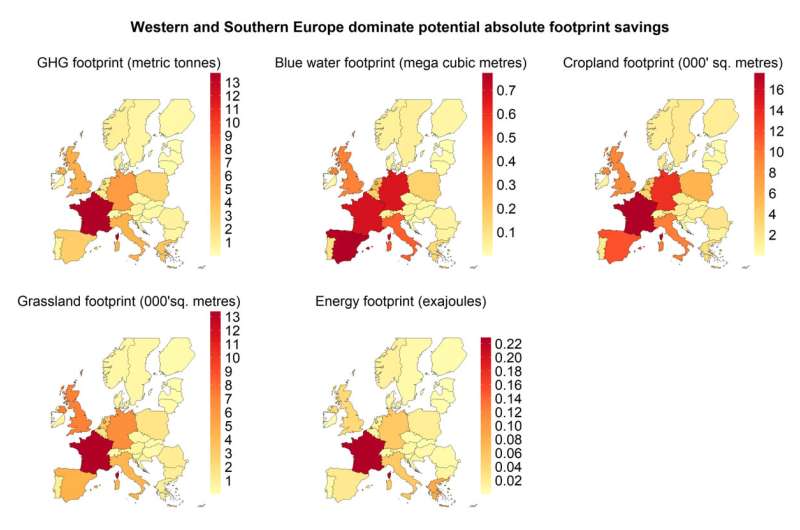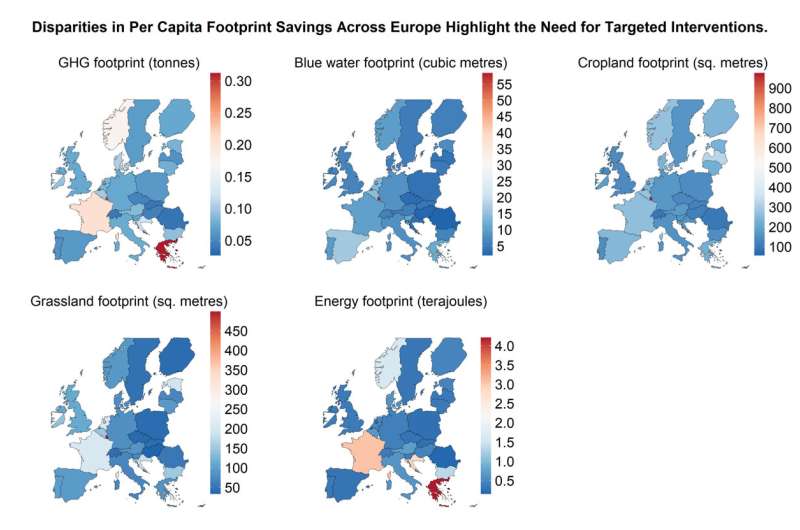This article has been reviewed according to Science X's editorial process and policies. Editors have highlighted the following attributes while ensuring the content's credibility:
fact-checked
peer-reviewed publication
trusted source
proofread
Food waste prevention in Europe can generate major footprint savings

New research shows that European food consumption draws unnecessarily excessively on global resources, which is why researchers are calling for political action. Many of the foods that are consumed in Europe are produced in countries outside Europe. Food loss—and waste later in the chain—occurs along the food supply chain, from the primary agricultural sector in Europe or rest of the world, until it feeds mouths in Europe.
"Halving Europe's food loss and waste, together with a redistribution of global food resources, could solve the challenges of food shortages in the world," says Marianne Thomsen, research leader and professor of sustainable food systems at the Department of Food Science at the University of Copenhagen (UCPH FOOD).
This is why countries should invest in solutions to reduce food loss and waste at all stages of the food supply chain, believes Marianne Thomsen.
Gains from reducing food loss and waste
The researchers' scenario calculations show what will happen if we halve the food loss and waste along the food supply chains associated with Europe's food consumption.
Halving food loss and waste in Europe's food supply chains equates to saving 8% of the greenhouse gas emissions caused by food consumption in Europe, along with an associated saving of 6% of agricultural areas and 6% of grazing areas—overall equaling 12% of agricultural areas—as grazing areas are used for livestock. In addition, there is a saving of 7% of water consumption, and 14 % of energy embodied in the food production for the citizens of Europe.
Marianne Thomsen points towards monitoring and reporting of food loss and waste by all actors along the food supply chain as an important policy instrument.
"Such a policy instrument may, supported by other types of policy instruments, be a strong incentive for companies and the rest of society to invest time and money in new technology and collaboration to prevent food loss and waste by closing the loop along the food supply chains within local circular food systems," she says.
Marianne Thomsen also provides some examples of where food waste can be prevented:
"The companies can collaborate on sustainable innovation in circular symbioses where side streams are utilized for producing upcycled ingredients and products. As another example, the service industry can apply upcycled ingredients produced from surplus food in the wholesale sector, while at the same time nudge costumers to take smaller portions by reducing the plate size," she explains.
A new angle on Europe's footprint
National greenhouse gas emission inventories are based on the amount of greenhouse gases emitted by individual countries from the food production that occurs within their own geographical borders.

The new calculations apply a consumption-based accounting approach. This includes the climate footprint from locally produced and imported food in European countries, while excluding domestically produced foods exported to other countries. In the scenario calculations, the researchers have assumed that the reduction in food loss and waste occurs through prevention, generating a reduction in food production and supply to satisfy European food consumption.
"Cutting food loss and waste caused by Europe's food consumption by 50% requires political intervention, and also that policy interventions are adapted to national circumstances and specific regional and local challenges," says Marianne Thomsen.
The calculations show that there are large regional differences determining the most effective intervention type. That said, Western Europeans show the greatest potential footprint savings, especially France, Germany, Belgium, and the Netherlands.
But also, countries with a lower gross domestic product, such as Greece, Croatia, Bulgaria, and Romania have great potential for food waste prevention. The agricultural sector shows the greatest potential for reducing the climate footprint, while the greatest potential for saving energy is found in the service industry, which includes canteens, hotels, and restaurants.
Waste terminology
In an international context, "food loss" occurs from the primary agricultural sector to the food processing industry and the wholesale sector, while from the retail sector towards the service industry and households, we refer to "food waste."
The calculations are based on world food production and trade in 2018. By reducing the food loss and waste resulting from European food consumption by 50%, the following consumption-based footprint savings can be achieved:
- 51 million tons CO2 equivalents (8%)
- 106,446 km2 agricultural land use (6%)
- 55,523 km2 use of grazing land (6%)
- 4.6 billion m3 water savings (7%)
- 131 terawatt-hours (0.47 exajoules) energy savings (14%)
The research is published in the journal Environmental Science & Technology.
More information: Albert Kwame Osei-Owusu et al, Potential Energy and Environmental Footprint Savings from Reducing Food Loss and Waste in Europe: A Scenario-Based Multiregional Input–Output Analysis, Environmental Science & Technology (2023). DOI: 10.1021/acs.est.3c00158
Journal information: Environmental Science & Technology
Provided by University of Copenhagen





















